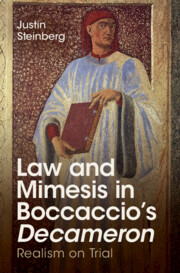Book contents
- Law and Mimesis in Boccaccio’s Decameron
- Law and Mimesis in Boccaccio’s Decameron
- Copyright page
- Contents
- Acknowledgments
- Introduction
- Chapter 1 The Novella on Trial
- Chapter 2 The Artist and the Police
- Chapter 3 The Widow and the Sovereign
- Chapter 4 Torture and the Sense of an Ending
- Chapter 5 Another Way of Possessing
- Chapter 6 The Author on Trial
- Bibliography
- Index
Chapter 4 - Torture and the Sense of an Ending
Published online by Cambridge University Press: 07 August 2023
- Law and Mimesis in Boccaccio’s Decameron
- Law and Mimesis in Boccaccio’s Decameron
- Copyright page
- Contents
- Acknowledgments
- Introduction
- Chapter 1 The Novella on Trial
- Chapter 2 The Artist and the Police
- Chapter 3 The Widow and the Sovereign
- Chapter 4 Torture and the Sense of an Ending
- Chapter 5 Another Way of Possessing
- Chapter 6 The Author on Trial
- Bibliography
- Index
Summary
The fourth chapter examines the depiction of torture in the Decameron. Boccaccio was fascinated by torture from both an epistemological and narratological standpoint. The greatest storyteller of the Middle Ages could not ignore the enticements of omniscience and narrative closure it proffers. The chapter argue specifically that Boccaccio saw a parallel between plot and due process, on the one hand, and torture and dénouement, on the other. What does torture tell us about the sense of an ending? The torture of Martellino by the sadistic Trevisan judge (2.1) is played as farce. In the tale of Zinevra-Sicruano (2.9), torture provides a happy ending within the fantasy world of romance. In the novella of Tedaldo (3.7), the romance of torture is domesticated by due process and the contingency of the novella form. Respect for due process and plot are abandoned in controversial final novella of the Decameron, the story of Griselda (10.10). After years of imposing unimaginable suffering on his young bride, Gualtieri finally gets his happy ending—but one that makes us question the nature of all endings.
- Type
- Chapter
- Information
- Law and Mimesis in Boccaccio's DecameronRealism on Trial, pp. 111 - 150Publisher: Cambridge University PressPrint publication year: 2023



